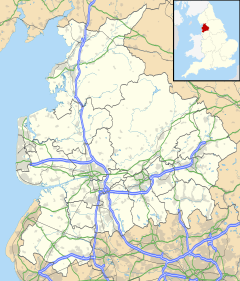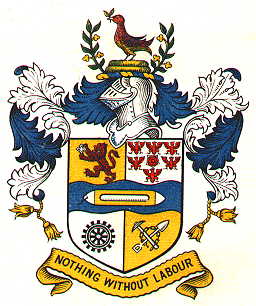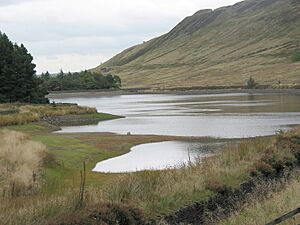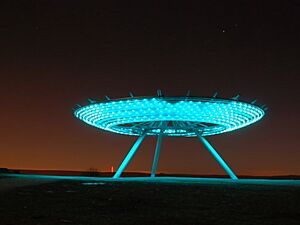Haslingden facts for kids
Quick facts for kids Haslingden |
|
|---|---|
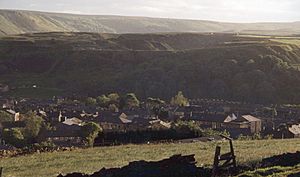 A view of Haslingden |
|
| Population | 16,849 (2001 Census) |
| OS grid reference | SD783232 |
| District | |
| Shire county | |
| Region | |
| Country | England |
| Sovereign state | United Kingdom |
| Post town | ROSSENDALE |
| Postcode district | BB4 |
| Dialling code | 01706 |
| Police | Lancashire |
| Fire | Lancashire |
| Ambulance | North West |
| EU Parliament | North West England |
| UK Parliament |
|
Haslingden is a town in Rossendale, Lancashire, England. It is about 16 miles (26 km) north of Manchester. The name 'Haslingden' means 'valley of the hazels'. In 2011, the town, including Helmshore, had about 15,969 people living there. High moorland surrounds the town.
Haslingden is famous as the birthplace of John Cockerill, a well-known industrialist. It is also where the composer Alan Rawsthorne was born. For many years, Michael Davitt, an Irish leader, lived here. Haslingden Cricket Club is part of the Lancashire League.
Contents
A Look Back in Time
People lived in the Haslingden area as far back as the Bronze Age. This was around 3000 BC. Thirteen Stones Hill, west of town, probably dates from this time. Today, only one stone can still be seen there.
Haslingden was once part of the Forest of Rossendale. This "forest" was a hunting park in the 13th and 14th centuries. It wasn't a thick forest, as most trees had gone much earlier. Haslingden was the main town in this area and had a church.
Haslingden started holding markets in the 1500s. It became a proper Market Town in 1676. During the Industrial Revolution, it grew into an important industrial town. Haslingden became rich from making wool and cotton cloth. This was thanks to new machines and the use of water and steam power. By the late 1800s, the area was known as 'The Golden Valley'.
In the 20th century, the number of people living in Haslingden went down. It dropped from 19,000 in 1911 to 15,000 in 1971. By 2001, the population was 16,849.
How Haslingden Grew
Stone from the Earth
Haslingden is well known for its stone quarries. A special type of stone called 'Haslingden Flag' was sent all over the country. This happened in the 1800s when railways made transport easier. This stone was even used to pave parts of London, like Trafalgar Square.
Flagstone is a type of rock that splits easily into flat slabs. This makes it perfect for paving. It was also used for fences and roofs locally. Geologists say it's as hard as granite. Its presence was the main reason quarrying grew in Rossendale.
From Wool to Cotton
Like many towns in East Lancashire, Haslingden has a long history with textiles. From the 1500s, farmers raised sheep and made woollen cloth. At first, this was done in small ways. But by the late 1700s, people started working together in small groups of houses. New machines also led to the first mills appearing.
Haslingden was not the best place for early water-powered mills. These were usually built lower down in river valleys, like nearby Helmshore. However, the town's experience with wool helped it switch to cotton weaving. Cotton was easier to spin with machines than wool.
Making cotton cloth became a very successful industry. But it also had a dark side. It was closely linked to the slave trade. Cotton goods were traded for African slaves, and cotton was picked by slaves in the southern U.S.
The growth of mills changed the landscape and the lives of workers. Factory work was often very hard and poorly paid. In 1826, almost 3,000 people in Haslingden attacked machines. They saw the machines as the cause of their problems. Soldiers were sent, and leaders were arrested.
By the 1850s, steam power took over from water power. Mills became much bigger. Slowly, things improved for factory workers. A minimum wage was introduced, and reformers helped. Haslingden then built successful mills on its higher land.
The cotton industry began to decline in the early 1900s. After the World Wars, other countries started making their own textiles. By the 1950s, many mills were closing. The old buildings were often used by smaller businesses for other things.
The Cockerill Family Story
William Cockerill (1759-1832) and his son John Cockerill (1790-1840) were born in Haslingden. William was a skilled inventor. He invented a machine called the Slubbing Billy, which twists yarn.
Father and son later moved to Belgium. There, they built one of the biggest industrial businesses in Europe. They are known for spreading the Industrial Revolution across the continent. John Cockerill became famous for his iron, steel, and machine-building factories. He was also known as a kind employer.
New People, New Communities
In the 1800s, when the cotton industry was booming, Haslingden attracted many new people. The port of Liverpool was a main entry point for immigrants. Many came to work in the mills.
From the late 1840s, many Irish immigrants came to Lancashire. They were escaping the Great Famine in Ireland. Some settled in Haslingden. Around the same time, Italian families also moved to the area. In the 1930s, refugees from Eastern Europe came to Haslingden to escape problems in their home countries. After World War II, young women from Germany also came to work in the mills and stayed.
From 1950 onwards, people from Commonwealth countries were encouraged to come. They helped in the textile industry after the war. Many young men came from Pakistan and later Bangladesh. They planned to save money and return home. But by the 1970s, many brought their families and settled in Haslingden for good.
Today, Haslingden has a lively community of people with South Asian roots. Most are from Bangladesh and Pakistan. Many families came from specific villages in Attock, Mirpur, and Sylhet. The town now has two mosques and many Asian grocery stores. In 2011, almost 4% of Rossendale's population identified as Muslim. Most of these live in Haslingden.
How Haslingden is Governed
Haslingden became a civil parish in 1866. A local board was set up in 1875 to manage the town. In 1891, Haslingden became a municipal borough. This meant it had its own local government. In 1974, Haslingden became part of the Borough of Rossendale due to changes in local government.
Famous Places in Haslingden
St James's Church: The Top of the Town
Haslingden's main Anglican church is dedicated to St James the Great. It was rebuilt in 1780. There has been a church on this spot since at least 1284. People call it the 'Top Church' because it stands high up.
The church is now north of the town centre. But until the 1930s, it was next to the 'Top of the Town' area. This was the old centre of Haslingden. It had pubs, the original market, and a place for travelling shows. This area was cleared in 1932. Now, new houses stand there.
Near the church entrance is a large plague stone. It has two carved holes. People think these stones were used during times of plague. Food could be left in the holes for sick people without direct contact. A Saxon Cross was mentioned in 1547, so the stone might be very old.
Other Churches in the Area
The Manchester Road Methodist Church is a beautiful building. It has an Italian-style inside. Other churches include St Thomas in Helmshore (1851) and the Roman Catholic Church of the Immaculate Conception (1859). Many other nonconformist churches were built in the early 1800s.
St Stephen's Church in Grane has an interesting story. It was built in 1867. But the building of the Ogden Reservoir meant almost everyone left Grane. In 1925, the villagers decided to move the church. They took it apart stone by stone and rebuilt it two miles away. Today, the church building is an antiques centre and cafe.
The Public Hall
The Public Hall opened in 1868. It was built by a group of working-class people and those who supported the temperance movement. The town council bought it in 1898. By the 1990s, it was not used much. It closed in 2005. The council then sold it to a group representing the Asian community. It is now a mosque.
The hall was once a place for famous speakers. Winston Churchill spoke there early in his political career. Emmeline Pankhurst, a leader for women's voting rights, also spoke from its stage. After the Battle of the Somme in 1916, it was used as a temporary hospital for soldiers.
Schools in Haslingden
The Wesleyan School was once the site of the world's first standardized intelligence test. This happened in 1903. It was suggested by Sir William Mather, an industrialist. The test included questions like "Is there a good reason for making a pie crust ornamental instead of plain?". Mather also brought in apprentice schemes at his factories. He also introduced a 48-hour working week for his workers.
Haslingden High School is a special school for arts, maths, and computing. Haslingden Primary School was rated 'Good' in its last inspection in 2014.
The Library and Michael Davitt
The Haslingden Mechanics' Institute opened in 1860. It became the public library in 1905. A blue plaque remembers Michael Davitt here. Young Davitt came to Haslingden with his family in 1840. They had been forced out of their farm in Ireland.
He started working in a cotton mill. But at age 11, his arm got caught in a machine and had to be removed. A local helper, John Dean, helped him get an education. Michael Davitt also took night classes at the Mechanics' Institute and used its library. His family home on Wilkinson Street is marked by a plaque.
The Railway
Haslingden used to have a railway connection to Accrington and Bury. The East Lancashire Railway built a station here. It closed to passengers in 1960 and to goods in 1964. The railway line itself closed in 1966.
Much of the old railway path is now covered by the A56 bypass. However, you can still see parts of the line through Helmshore. There are also some amazing bridges still standing near Stubbins. The East Lancashire Railway Preservation Society first started at Helmshore Station. They wanted to reopen the line. Later, they moved to Bury and reopened the line from Rawtenstall to Bury.
The closest train station for national rail services is 4 miles away in Accrington. There have been ideas to start a regular train service from Rawtenstall to Manchester.
Other Interesting Places
In the town centre, you'll find the famous Big Lamp. It was first put up in 1841. All distances in Haslingden are measured from here. The original lamp is now gone, replaced by a copy.
Cissy Green's Bakery on Deardengate is well-known. People come from all over Lancashire for their handmade pies. These pies are still made using a recipe from the 1920s. North of town is the Holland's Pies factory. Winfield's is a large store selling shoes and clothes. It promotes itself as a fun family day out.
Haslingden's War Memorial is special because it has no names on it. To the northeast, there is a digital television transmitter that serves a large area.
Chris Aspin wrote about a haunting at Tor View. This house is no longer standing. It was behind the Rose & Crown pub. A young woman named Emma Walton died there in the 1840s after a sad love story. This ghost story was told in a book in 1956.
Nature and Beauty Spots
West of Haslingden, there is a large area of moorland. These moors are part of the West Pennine Moors. In 2007, plans were made to build a wind farm with twelve wind turbines on the moors. This plan was approved in 2010. It is still a topic of discussion.
Snighole in Helmshore is a well-known beauty spot. The Grane Valley, with its three reservoirs, is popular with walkers.
Victoria Park has a bowling green, a children's playground, a skateboard park, and a ball court. From the top of the park, you can see Musbury Hill.
The Halo Artwork
The Halo is a special artwork designed by John Kennedy. It was chosen in a competition in 2003 and opened in 2007. It sits in the hills above Haslingden. It is the main feature of a restored landscape. At night, it glows and offers an amazing view.
Famous People from Haslingden

- William Cockerill (1759–1832): An inventor and industrialist.
- John Cockerill (1790–1840): A famous industrialist and businessman in Belgium.
- Sir James Duckworth (1840–1915): A businessman who started a large chain of grocery shops. He was also a mayor and a Member of Parliament.
- Michael Davitt (1846–1906): An Irish leader and Member of Parliament. In 2006, the Irish President, Mary McAleese, unveiled a new memorial to Davitt.
- Robert Scott (1874–1961): He received the Victoria Cross for bravery during the Second Boer War.
- Beryl Ingham (1901–1960): A clog dancer and the wife and manager of George Formby.
- Alan Rawsthorne (1905–1971): A British composer.
- Sir Rhodes Boyson (1925–2012): A head teacher, local council member, and a Conservative Member of Parliament and government minister.
- Chris Aspin (1933-2024): A journalist, historian, and author who wrote about the local textile industry.
- Dave Pearson (1937–2008): A painter and teacher who had a studio in Haslingden.
Sports Stars
- Choppy Warburton (1845–1897): Born in Haslingden, he was a record-breaking runner and a cycling coach. He was even painted by Toulouse-Lautrec.
- Armour Ashe (1925–1968): A footballer who played for Accrington Stanley.
- Clive Lloyd (born 1944): A famous West Indies and Lancashire C.C.C. cricketer who also played for Haslingden.
Images for kids
See also
 In Spanish: Haslingden para niños
In Spanish: Haslingden para niños


